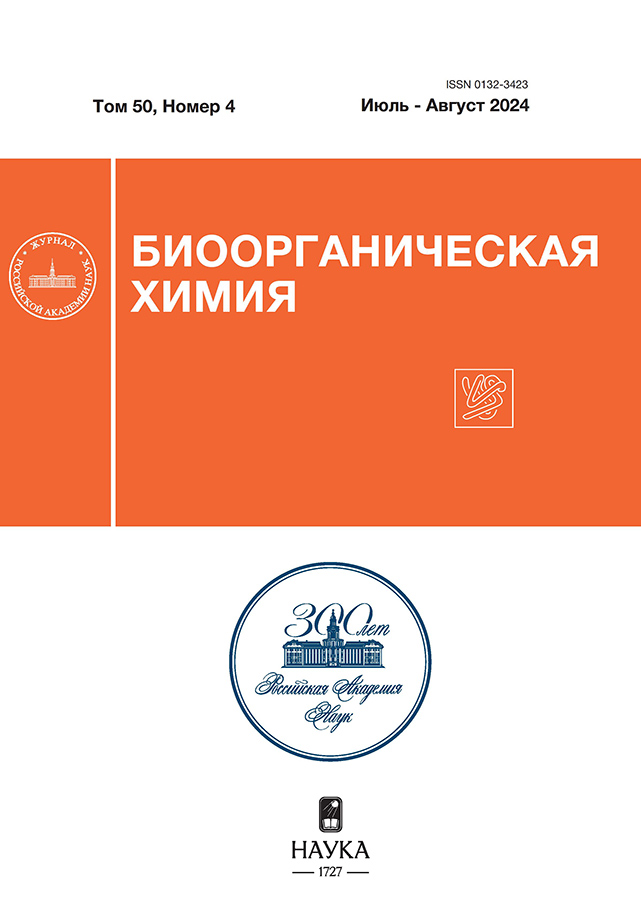Biotechnological Production of the Recombinant Two-Component Lantibiotic Lichenicidin in the Bacterial Expression System
- Authors: Antoshina D.V.1, Balandin S.V.1,2, Tagaev A.A.1, Potemkina A.A.1,2, Ovchinnikova T.V.1,2
-
Affiliations:
- Shemyakin–Ovchinnikov Institute of Bioorganic Chemistry Russian Academy of Sciences
- Moscow Institute of Physics and Technology (National Research University)
- Issue: Vol 50, No 4 (2024)
- Pages: 485-497
- Section: Articles
- URL: https://ter-arkhiv.ru/0132-3423/article/view/670845
- DOI: https://doi.org/10.31857/S0132342324040081
- EDN: https://elibrary.ru/MWYNGK
- ID: 670845
Cite item
Abstract
Lantibiotics are a family of bacterial antimicrobial peptides synthesized by ribosomes that undergo post-translational modification to form lanthionine (Lan) and methyllanthionine (MeLan) residues. Lantibiotics are considered promising agents for combating antibiotic-resistant bacterial infections. This paper presents a biotechnological method for obtaining two components of the lantibiotic lichenicidin from Bacillus licheniformis B-511 – Lchα and Lchβ. A system has been developed that allows co-expression of the lchA1 or lchA2 genes, encoding the precursors of the α- or β-components, respectively, with the lchM1 or lchM2 genes of the modifying enzymes LchM1 and LchM2 in Escherichia coli cells. The developed system of heterologous expression and purification made it possible to obtain, with high yield, post-translationally modified recombinant Lchβ, completely identical to the natural peptide in structure and biological activity.
Full Text
About the authors
D. V. Antoshina
Shemyakin–Ovchinnikov Institute of Bioorganic Chemistry Russian Academy of Sciences
Email: ovch@ibch.ru
Russian Federation, ul. Miklukho-Maklaya 16/10, Moscow, 117997
S. V. Balandin
Shemyakin–Ovchinnikov Institute of Bioorganic Chemistry Russian Academy of Sciences; Moscow Institute of Physics and Technology (National Research University)
Email: ovch@ibch.ru
Phystech School of Biological and Medical Physics
Russian Federation, ul. Miklukho-Maklaya 16/10, Moscow, 117997; Institutskiy per. 9, Dolgoprudny, 141700A. A. Tagaev
Shemyakin–Ovchinnikov Institute of Bioorganic Chemistry Russian Academy of Sciences
Email: ovch@ibch.ru
Russian Federation, ul. Miklukho-Maklaya 16/10, Moscow, 117997
A. A. Potemkina
Shemyakin–Ovchinnikov Institute of Bioorganic Chemistry Russian Academy of Sciences; Moscow Institute of Physics and Technology (National Research University)
Email: ovch@ibch.ru
Phystech School of Biological and Medical Physics
Russian Federation, ul. Miklukho-Maklaya 16/10, Moscow, 117997; Institutskiy per. 9, Dolgoprudny, 141700T. V. Ovchinnikova
Shemyakin–Ovchinnikov Institute of Bioorganic Chemistry Russian Academy of Sciences; Moscow Institute of Physics and Technology (National Research University)
Author for correspondence.
Email: ovch@ibch.ru
Phystech School of Biological and Medical Physics
Russian Federation, ul. Miklukho-Maklaya 16/10, Moscow, 117997; Institutskiy per. 9, Dolgoprudny, 141700References
- Drider D., Rebuffat S. Prokaryotic Antimicrobial Peptides. From Genes to Applications / Springer. 2011. P. 1–451.
- Antoshina D.V., Balandin S.V., Ovchinnikova T.V. // Biochemistry (Moscow). 2022. V. 87. P. 1387–1403. https://doi.org/10.1134/S0006297922110165
- Zimina M., Babich O., Prosekov A., Sukhikh S., Ivanova S., Shevchenko M., Noskova S. // Antibiotics (Basel). 2020. V. 9. P. 553–574. https://doi.org/10.3390/antibiotics9090553
- Field D., Cotter P.D., Hill C., Ross R.P. // Front. Microbiol. 2015. V. 6. P. 1–8. https://doi.org/10.3389/fmicb.2015.01363
- Repka L.M., Chekan J.R., Nair S.K., van der Donk W.A. // Chem. Rev. 2017. V. 11. P. 5457–5520. https://doi.org/10.1021/acs.chemrev.6b00591
- Ryan M.P., Rea M.C., Hill C., Ross R.P. // Appl. Environ. Microbiol. 1996. V. 62. P. 612–619. https://doi.org/10.1128/aem.62.2.612-619.1996
- Navaratna M.A., Sahl H.G., Tagg J.R. // Infect. Immun. 1999. V. 67. P. 4268–4271. https://doi.org/10.1128/iai.67.8.4268-4271.1999
- Holo H., Jeknic Z., Daeschel M., Stevanovic S., Nes I.F. // Microbiology (Reading). 2001. V. 147. P. 643–651. https://doi.org/10.1099/00221287-147-3-643
- Hyink O., Balakrishnan M., Tagg J.R. // FEMS Microbiol. Lett. 2005. V. 252. P. 235–241. https://doi.org/10.1016/j.femsle.2005.09.003
- Yonezawa H., Kuramitsu H.K. // Antimicrob. Agents Chemother. 2005. V. 49. P. 541–548. https://doi.org/10.1128%2FAAC.49.2.541-548.2005
- Begley M., Cotter P.D., Hill C., Ross R.P. // Appl. Environ. Microbiol. 2009. V. 75. P. 5451–5460. https://doi.org/10.1128/aem.00730-09
- Shenkarev Z.O., Finkina E.I., Nurmukhamedova E.K., Balandin S.V., Mineev K.S., Nadezhdin K.D., Yakimenko Z.A., Tagaev A.A., Temirov Y.V., Arseniev A.S., Ovchinnikova T.V. // Biochem. 2010. V. 49. P. 6462– 6472. https://doi.org/10.1021/bi100871b
- Barbosa J.C., Gonçalves S., Makowski M., Silva Í.C., Caetano T., Schneider T., Mösker E., Süssmuth R.D., Santos N.C., Mendo S. // Coll. Surf. B Biointerfaces. 2022. V. 211. P. 1–11. https://doi.org/10.1016/j.colsurfb.2021.112308
- Panina I.S., Balandin S.V., Tsarev A.V., Chugunov A.O., Tagaev A.A., Finkina E.I., Antoshina D.V., Sheremeteva E.V., Paramonov A.S., Rickmeyer J., Bierbaum G., Efremov R.G., Shenkarev Z.O., Ovchinnikova T.V. // Int. J. Mol. Sci. 2023. V. 24. P. 1332. https://doi.org/10.3390/ijms24021332
- McClerren A.L., Cooper L.E., Quan C., Thomas P.M., Kelleher N.L., van der Donk W.A. // Proc. Natl. Acad. Sci USA. 2006. V. 103. P. 17243–17248. https://doi.org/10.1073/pnas.0606088103
- Sawa N., Wilaipun P., Kinoshita S., Zendo T., Leelawatcharamas V., Nakayama J., Sonomoto K. // Appl. Environ. Microbiol. 2012. V. 78. P. 900–903. https://doi.org/10.1128/aem.06497-11
- Zhao X., van der Donk W.A. // Cell Chem. Biol. 2016. V. 23. P. 246–256. https://doi.org/10.1016/j.chembiol.2015.11.014
- Huo L., van der Donk W.A. // J. Am. Chem. Soc. 2016. V. 138. P. 5254–5257. https://doi.org/10.1021/jacs.6b02513
- Xin B., Zheng J., Liu H., Li J., Ruan L., Peng D., Sajid M., Sun M. // Front Microbiol. 2016. V. 7. P. 1–12. https://doi.org/10.3389/fmicb.2016.01115
- Collins F.W.J., O’Connor P.M., O’Sullivan O., Rea M.C., Hill C., Ross R.P. // Microbiology (Reading). 2016. V. 162. P. 1662–1671. https://doi.org/10.1099/mic.0.000340
- Singh M., Chaudhary S., Sareen D. // Mol. Microbiol. 2020. V. 113. P. 326–337. https://doi.org/10.1111/mmi.14419
- Caetano T., Krawczyk J.M., Mösker E., Süssmuth R.D., Mendo S. // Chem. Biol. 2011. V. 18. P. 90–100. https://doi.org/10.1016/j.chembiol.2010.11.010
- Caetano T., Barbosa J., Möesker E., Süssmuth R.D., Mendo S. // Res Microbiol. 2014. V. 165. P. 600–604. https://doi.org/10.1016/j.resmic.2014.07.006
- Jones D.H., Howard B.H. // BioTechniques. 1991. V. 10. P. 62–66.
Supplementary files
















